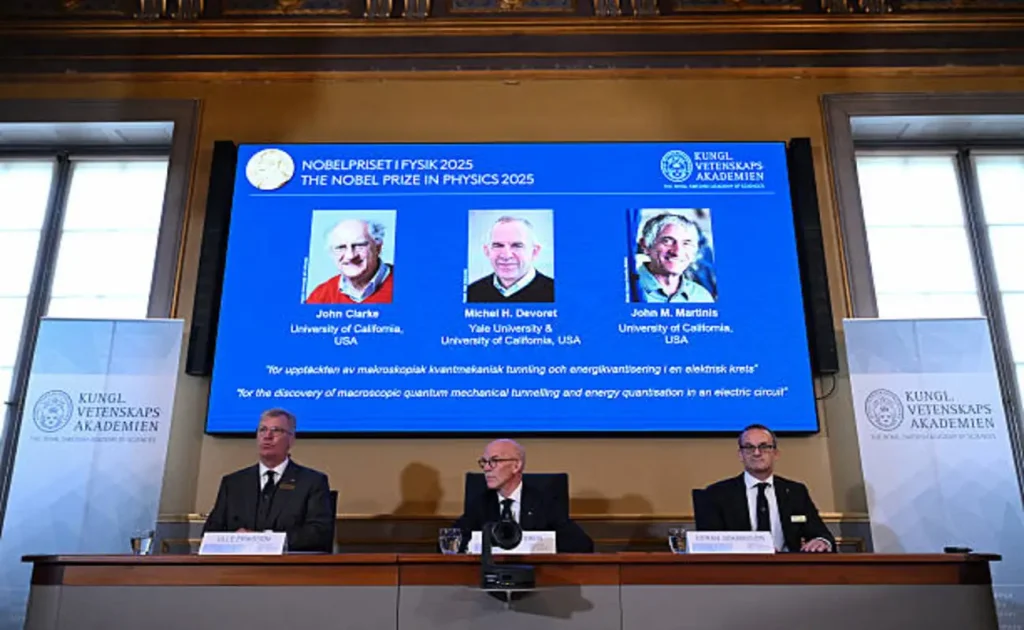
Olle Eriksson, Hans Ellegren, and Goeran Johansson announce the 2025 Nobel Physics winners in Stockholm, Sweden, on October 7, 2025. Image credit/ Jonathan Nackstrand AFP
The Royal Swedish Academy of Sciences awarded the trio for the “discovery of macroscopic quantum mechanical tunnelling and energy quantisation in an electric circuit.”
Quantum Physics in Action
The jury praised their experiments conducted during the 1980s, which demonstrated that quantum phenomena could extend to larger systems, bridging the microscopic and macroscopic worlds.
Quantum mechanics, the foundation of modern physics, governs the behavior of particles at subatomic scales.
On that scale, particles behave differently from the physical objects humans encounter daily.
For example, when a ball hits a wall, it rebounds. But in the quantum realm, a particle can tunnel through barriers, emerging on the other side—a phenomenon known as “tunnelling.”
Macroscopic Quantum Tunnelling Explained
The researchers’ key contribution was showing that quantum tunnelling can also occur on a macroscopic scale involving multiple particles.
They achieved this through the use of superconductors—materials that conduct electricity with zero resistance at very low temperatures.
By manipulating these superconductors, Clarke, Devoret, and Martinis demonstrated that macroscopic systems could exhibit quantum mechanical properties, defying classical physics assumptions.
The Royal Swedish Academy said in its statement that the trio’s findings proved “the bizarre properties of the quantum world can be made concrete in a system big enough to be held in the hand.”
Such results, the Academy added, “opened the door for new fields of quantum research and potential technological revolutions.”
Bridging Two Worlds Through Science
Physicist Michel Devoret, based at Yale University, described the Nobel recognition as “an incredible honor and a sign that our fundamental curiosity about nature has practical consequences.”
John Clarke, from the University of California, Berkeley, said the discovery “was born out of a desire to test the limits of quantum behavior.”
John Martinis, who has also worked with Google’s Quantum AI Laboratory, said the research “helped pave the way for modern quantum computing.”
Quantum computing aims to use the strange properties of quantum mechanics to perform calculations far beyond the capabilities of conventional computers.
“This discovery showed us that quantum effects could be engineered at human scales, not just observed in particle accelerators,” Martinis said.
According to the Nobel jury, the findings form “the experimental backbone of a rapidly advancing scientific frontier.”
From Theory to Real-World Application
Quantum tunnelling is a process where particles overcome energy barriers without the required energy to do so by classical standards.
Before the 1980s, scientists considered tunnelling a microscopic effect limited to electrons or atomic particles.
The new experiments overturned that assumption by revealing that entire systems—comprising billions of atoms—could exhibit the same phenomena.
Superconducting circuits used in the experiments became the basis for the development of quantum bits, or qubits, essential components of quantum computers.
These insights directly contributed to the creation of superconducting qubits now used by major research institutions and private laboratories worldwide.
Experts say the 2025 Nobel recognition underscores the growing importance of fundamental physics in driving real-world technologies.
Global Recognition of Quantum Advancement
The Nobel Committee emphasized that the trio’s discoveries “link theoretical physics to technological progress.”
According to the Academy, their achievements illustrate how quantum theory, once seen as purely abstract, can produce tangible innovations.
The committee also noted that the laureates’ collaborative efforts across institutions in the United Kingdom, France, and the United States highlight the global nature of scientific discovery.
“This year’s laureates remind us that curiosity-driven research can yield results that transform our technological landscape,” the Nobel jury said.
The Nobel Prize in Physics carries a total award of 11 million Swedish kronor, or approximately $1 million, shared equally among the winners.
Each laureate will receive a gold medal and diploma during the Nobel ceremony in Stockholm this December.
Past winners of the prize include Albert Einstein, Niels Bohr, and Peter Higgs, whose discoveries similarly reshaped humanity’s understanding of nature.
Future Prospects in Quantum Technology
Scientists around the world believe that the laureates’ contributions have set the foundation for the next era of quantum technology.
These include advances in quantum sensors, secure communications, and computers capable of solving problems previously deemed impossible.
Physicist Devoret added that “the most exciting part is that the real applications are still ahead of us.”
John Martinis echoed that sentiment, saying the research “was never about winning prizes but understanding how deeply nature allows us to manipulate reality.”
John Clarke, reflecting on the journey, said, “Our experiments began in curiosity, but their impact continues to surprise even us.”
As global research accelerates, the Nobel Committee noted that the laureates’ pioneering work will remain a cornerstone of the modern quantum revolution.
Reporting by James; additional reporting by the Royal Swedish Academy of Sciences, Stockholm. Edited for Epicstorian News.


